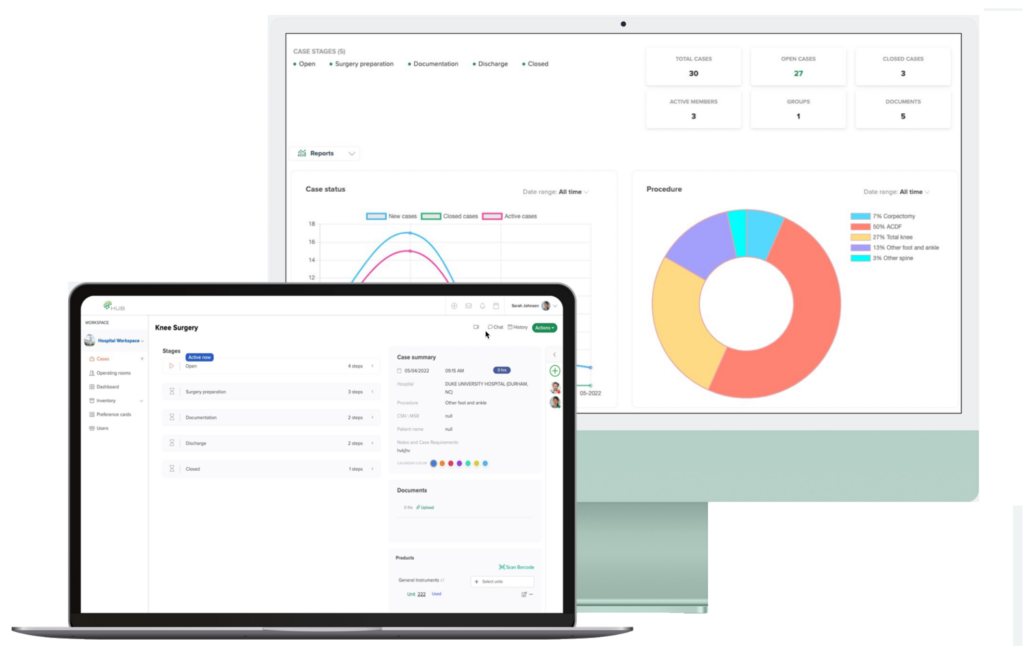How to Kickstart Your Career in Medical Device Sales as a Distributor
The pathway to becoming a medical device distributor is multifaceted, intertwining industry know-how with strategic business planning. Here’s a step-by-step guide to enter this lucrative field and align yourself with the best medical device companies to work for.
Research and Understand the Market
Kick off with a thorough market analysis. Scrutinize current trends, demands, and the competitive landscape within the medical device sales industry. This foundational knowledge will help you pinpoint opportunities and target the best niches for your business.
To research and understand the medical device market, here are five effective strategies:
Industry Reports and Market Analysis:
- Access detailed reports from market research firms such as Frost & Sullivan, Gartner, or MarketsandMarkets. These reports often provide comprehensive insights into market trends, size, growth projections, competitive landscapes, and future outlooks. They can be costly but are typically rich in data and analysis.
Government and Regulatory Body Publications:
- Regulatory bodies like the FDA in the U.S., EMA in Europe, and others often publish reports and guidelines that can give insights into market requirements, regulatory changes, and approval processes. The National Association of Boards of Pharmacy and local state health services like the Texas DSHS also provide resources that can shed light on compliance and industry standards.
Trade Shows and Conferences:
- Attending medical device trade shows and conferences is an invaluable way to network with industry professionals, learn about the latest technologies, and understand the needs and challenges of the market. It’s also a chance to gather firsthand information on what products and innovations are shaping the industry.
Online Databases and Medical Journals:
- Databases like PubMed offer access to a plethora of medical journals where you can find studies and articles related to medical devices. This can be useful for understanding the scientific and technical advancements in the field, as well as emerging medical needs that new devices might address.
Competitive Analysis:
- Conduct a competitive analysis by examining the product lines, market presence, and business strategies of current players in the medical device market. This includes reviewing competitors’ websites, analyzing their marketing activities, and studying their customer feedback. Tools like SWOT analysis can help to identify your potential competitive advantages and challenges.
Legal Compliance and Accreditation
Securing the appropriate licenses and permits is non-negotiable. Depending on your location, this may entail obtaining a business license, a tax ID number, and registering with the FDA, especially if you’re planning to distribute medical devices. Furthermore, consider obtaining Drug Distributor Accreditation from organizations like the National Association of Boards of Pharmacy to bolster your credibility and ensure compliance with industry standards.
Read our post on Legal Considerations Here
Building Supplier Relationships
Forge strong connections with manufacturers to ensure a steady supply of innovative medical devices. Your goal is to offer quality products that stand out in the medical device sales companies’ market, providing value to healthcare professionals and facilities.
Building supplier relationships is a critical step in becoming a successful medical device distributor. Here’s an expanded view of how to establish and nurture these connections:
1. Identify Potential Suppliers
Begin by conducting extensive research to identify potential suppliers. This includes exploring manufacturers of different medical devices, from general medical supplies to specialized equipment. You can leverage industry databases, attend trade shows, and read medical journals to find reputable companies. Prioritize suppliers with a strong track record of quality products and innovation.
2. Evaluate Product Quality and Range
Assess the quality of products from these suppliers by requesting samples, reviewing clinical trial data, and seeking feedback from healthcare professionals. The range of products is also important; a diverse product line can open up multiple streams of revenue and cater to a wider client base. However, balance this with a focus on niche markets where you can offer specialized knowledge and products.
3. Negotiate Terms and Agreements
Once you’ve identified suppliers with whom you’d like to work, negotiate terms that are mutually beneficial. This may include exclusive distribution rights for certain products or regions, bulk purchasing agreements, or consignment arrangements. Make sure to also discuss return policies, warranty terms, and support services, as these can be key selling points for your clients.
4. Collaborate on Marketing Efforts
Strong supplier relationships often involve collaborative marketing efforts. This could mean co-branding at industry events, creating joint marketing materials, or even co-hosting webinars and educational workshops. Such collaborations can enhance the visibility of both your distribution business and the supplier’s products.
5. Continuous Communication and Feedback Loop
Establish a communication channel for ongoing dialogue with suppliers. Regular updates on market trends, customer feedback, and sales performance can help suppliers improve or create products that better meet the needs of the market. This feedback loop can also inform your inventory decisions and marketing strategies.
6. Build Trust Through Transparency and Reliability
Trust is the foundation of any strong relationship. Be transparent about your business practices and reliable in your commitments. Pay invoices on time, adhere to agreed-upon terms, and communicate openly about any challenges that arise. A reputation for integrity can make you a preferred partner for suppliers.
7. Leverage Technology for Efficient Collaboration
Utilize technology to streamline your interactions. This can include electronic data interchange (EDI) for order processing, inventory management systems to track stock levels, and customer relationship management (CRM) software to document all interactions and agreements.
Marketing and Sales Strategy
Develop a robust marketing plan to promote your portfolio. Craft a buyer persona to target your marketing efforts effectively, and ensure your sales and marketing teams are in sync to provide seamless customer service.
Investment in Logistics
Investment in logistics is essential for the success of any medical device distribution enterprise, and a comprehensive system like HUB Healthcare can streamline this complex process. Here’s a condensed guide focusing on three key areas:
Integrated Logistics and Inventory Management
HUB Healthcare provides a robust platform that combines inventory management with advanced logistics. This integration ensures that medical devices are tracked, from warehousing to delivery, in real-time. The system’s analytics help maintain optimal stock levels, prevent shortages, and manage warehouse space efficiently, leading to significant cost savings and enhanced service delivery.
Compliance and Customer Service
The platform’s compliance management tools ensure that all logistics operations align with healthcare regulations, mitigating the risk of fines and enhancing trust with healthcare professionals. A customer-centric approach is embedded in the platform, with automated notifications and real-time updates on order status, thereby improving transparency and customer satisfaction.
Efficiency and Analytics
HUB Healthcare’s logistics solutions are designed to optimize delivery routes and consolidate shipments, which can reduce shipping costs and improve delivery times. Advanced analytics provided by the platform enables data-driven decision-making, anticipating demand, and improving resource management. This strategic approach to logistics ensures that medical devices are delivered swiftly, cost-effectively, and in compliance with industry standards, solidifying your reputation as a reliable distributor in the medical device market.
By focusing on these three core areas, HUB Healthcare’s solution addresses the key challenges of medical device distribution, making it an indispensable tool for distributors looking to improve their logistics operations.
Customer Service Excellence
In medical device sales, customer service is paramount. Your clients, which include healthcare providers and institutions, depend on your products for patient care. Thus, delivering impeccable service is crucial for success and client retention.
Competitive Salary and Expansion
A medical device rep salary can vary widely, often reflecting the level of expertise and the value of the devices being sold. Stay competitive by continuously expanding your product line to include the latest technological advancements in the medical field.
If you’re considering a career as a medical device sales representative, it’s important to have a clear understanding of the potential earnings. Salaries can vary widely based on factors like location, experience, company, and performance.
In 2024, the average base salary for a medical device sales representative was reported to be around $61,018, with additional earnings from bonuses, profit sharing, and commission potentially bringing total pay to a range between $43,000 to $128,000 annually. Specific earnings can vary, for instance, in California, the average salary was noted to be $136,422, with the range typically falling between $117,844 and $160,525 depending on various factors such as the city and experience level.
For entry-level positions, medical sales representatives can expect offers between $45,000 to $75,000 per year, depending on prior experience and track record in sales. With progression in their career, the earning potential increases significantly.
Specializations within medical sales can also impact salary. For instance, salaries in the biotech sector start at around $103,300 with the potential for additional commission, while medical device sales can start at a base of $74,005 and see significant commission on top of that.
Compensation for medical device distributors often includes a base salary plus a percentage of the sales they generate, known as commission. The specific percentage can vary widely depending on the company, the complexity of the products, and the terms of the distributor’s contract. For example, a distributor might earn a 10-20% commission on direct sales, but this rate can be higher for specialized equipment or more lucrative deals.
To provide accurate and detailed information about compensation, including percentages earned on sales, it is recommended to consult industry-specific resources or websites that specialize in salary data. Here are a few resources where you can find more information:
PayScale: Offers insights into average salaries, bonuses, profit sharing, and commission for medical device sales representatives. It provides tools to help you understand how factors like location, experience, and skill level can impact earnings. Visit PayScale
Salary.com: A comprehensive resource for salary data, including medical device sales representatives’ base pay and bonuses. This website allows you to search for salary information by city or state, which can help you understand regional differences in earnings. Visit Salary.com
Indeed Salary Search: This tool allows you to search for salaries and compensation based on job title and location. You can find information on what medical device distributors might earn, including potential commissions. Visit Indeed
Glassdoor: On Glassdoor, you can find salary information submitted by employees, which often includes detailed breakdowns of base salary, commission, and other forms of compensation. Visit Glassdoor
When searching for compensation data, be sure to look for information relevant to your specific situation, including your geographic area, industry sector, and the size of the company you’re interested in. It’s also a good idea to review multiple sources to get a comprehensive view of the potential earnings for medical device distributors.
Building a Reputation
Cultivating a strong reputation takes time. However, by consistently meeting customer needs with timely, high-quality solutions, you’ll establish a name for yourself as a trusted medical device distributor.
In conclusion, becoming a successful medical device distributor involves market research, compliance with legal regulations, establishing strong relationships with suppliers, strategic marketing, robust logistics, exemplary customer service, and continuous growth and adaptation to market needs. With dedication and strategic planning, you can create a thriving distribution business in the medical device sector.







